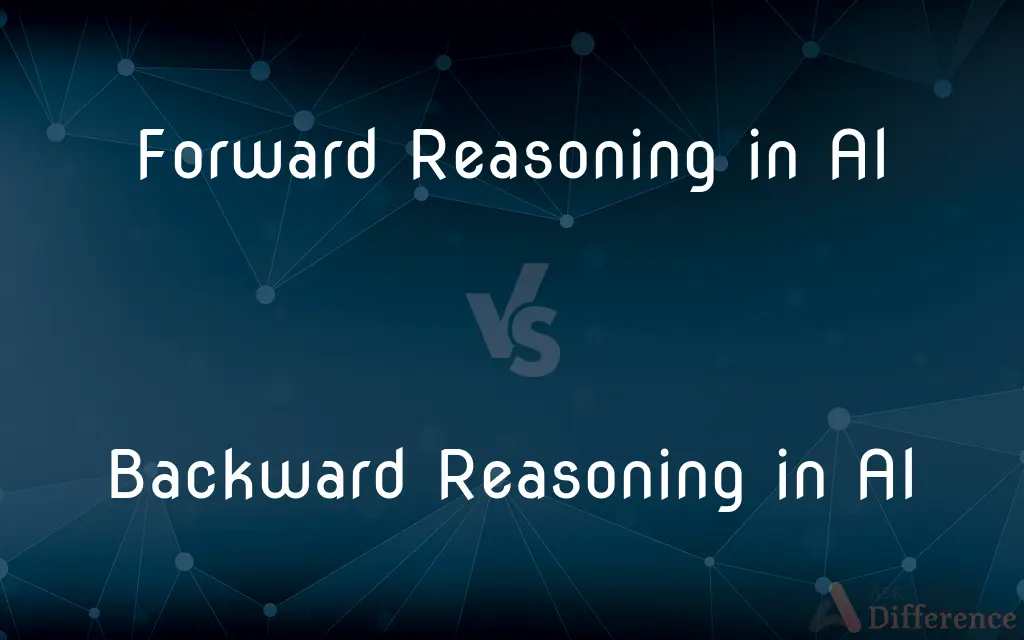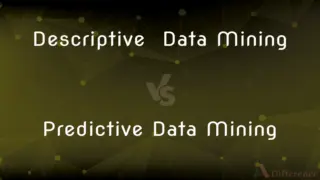Forward Reasoning in AI vs. Backward Reasoning in AI — What's the Difference?
By Tayyaba Rehman — Published on January 6, 2024
Forward Reasoning in AI progresses from known facts to new conclusions. Backward Reasoning in AI starts with a goal and works backwards to find supporting facts.

Difference Between Forward Reasoning in AI and Backward Reasoning in AI
Table of Contents
ADVERTISEMENT
Key Differences
Forward Reasoning in AI involves starting with known data or premises and deriving new conclusions or outcomes. It's a proactive approach where AI systems build upon existing knowledge. In contrast, Backward Reasoning in AI begins with a desired conclusion or goal and works backward to determine the necessary conditions or premises needed to achieve that goal.
In Forward Reasoning in AI, the process is often data-driven, where the AI system explores multiple pathways from given information, leading to various possible outcomes. Conversely, Backward Reasoning in AI is goal-driven, focusing on finding a solution path that leads to a specific target or conclusion, often ignoring irrelevant data paths.
Forward Reasoning in AI is commonly used in applications where the exploration of all possible outcomes from known conditions is necessary, like in predictive analytics. Backward Reasoning in AI is more prevalent in problem-solving scenarios, such as in diagnostic systems or when working with incomplete information to reach a known goal.
The efficiency of Forward Reasoning in AI can be impacted by the volume of data and potential outcomes, leading to increased computational complexity. Backward Reasoning in AI is more focused and can be more efficient in situations where the end goal is clear but the path to reach it is not.
Forward Reasoning in AI is akin to building a map from a starting point, exploring all routes. Backward Reasoning in AI, on the other hand, is like starting from the destination and tracing back the most efficient route to the start.
ADVERTISEMENT
Comparison Chart
Starting Point
Begins with known facts or data.
Starts with a desired conclusion or goal.
Approach
Data-driven, exploring multiple outcomes.
Goal-driven, focusing on a specific solution path.
Common Use Cases
Predictive analytics, exploring possibilities.
Problem-solving, diagnostics, achieving specific goals.
Efficiency
Can be less efficient with large data sets.
More focused, often more efficient with a clear end goal.
Methodology
Builds on existing knowledge to form new conclusions.
Works backward from the goal to find supporting conditions.
Compare with Definitions
Forward Reasoning in AI
Explores multiple pathways from given information.
Using forward reasoning, the AI system identified potential health risks based on patient history.
Backward Reasoning in AI
Goal-driven, focusing on specific solution paths.
To solve the puzzle, the AI applied backward reasoning, working from the end goal.
Forward Reasoning in AI
Data-driven approach building upon existing knowledge.
The AI applied forward reasoning to expand its knowledge base from current facts.
Backward Reasoning in AI
Starts from a goal to find necessary supporting facts.
The AI used backward reasoning to diagnose the issue by starting from the symptoms.
Forward Reasoning in AI
Used in predictive analytics for exploring possibilities.
Forward reasoning enabled the AI to forecast weather patterns accurately.
Backward Reasoning in AI
Efficient in problem-solving with a clear end goal.
Backward reasoning helped the AI quickly identify the route in the navigation system.
Forward Reasoning in AI
Progresses from premises to new outcomes.
The AI system employed forward reasoning to innovate new engineering solutions.
Backward Reasoning in AI
Ignores irrelevant data paths, focusing on the goal.
To optimize the production process, the AI system utilized backward reasoning.
Forward Reasoning in AI
Derives new conclusions from known data.
The AI used forward reasoning to predict market trends from historical data.
Backward Reasoning in AI
Works backward from conclusion to premises.
In legal analysis, the AI used backward reasoning to trace the evidence back to laws.
Common Curiosities
What is Backward Reasoning in AI?
An AI reasoning method that starts with a goal and works backwards to find supporting facts.
Where is Forward Reasoning in AI commonly used?
In scenarios like predictive analytics and exploring various outcomes.
What is Forward Reasoning in AI?
It's an approach where AI progresses from known facts to derive new conclusions.
Can Forward Reasoning in AI predict future events?
Yes, it's often used to predict future outcomes based on existing data.
What type of problems is Backward Reasoning in AI best suited for?
Ideal for problem-solving, diagnostics, and when a specific goal is targeted.
How does Forward Reasoning in AI handle large data sets?
It can become less efficient due to the exploration of multiple outcomes.
Which is more data-driven: Forward or Backward Reasoning in AI?
Forward Reasoning is more data-driven, exploring all possible data paths.
Can Forward Reasoning in AI lead to innovation?
Yes, by exploring new possibilities and outcomes from known facts.
How do AI systems apply Forward Reasoning in healthcare?
By analyzing patient data to predict health risks and outcomes.
Is Backward Reasoning in AI more focused than Forward Reasoning?
Yes, it’s more focused, working specifically towards a known goal.
How does Backward Reasoning in AI aid in diagnostics?
By starting with symptoms (goals) and working backward to identify causes.
Does Backward Reasoning in AI ignore irrelevant information?
Yes, it focuses only on information relevant to the end goal.
Which reasoning method is better for a wide exploration of outcomes?
Forward Reasoning is better for exploring a wide range of possible outcomes.
Is Backward Reasoning in AI used in navigation systems?
Yes, particularly in finding efficient routes by working backward from the destination.
Can Backward Reasoning in AI be used in legal analysis?
Yes, to trace evidence back to specific laws or precedents.
Share Your Discovery

Previous Comparison
Ethanol vs. Methoxymethane
Next Comparison
Descriptive Data Mining vs. Predictive Data MiningAuthor Spotlight
Written by
Tayyaba RehmanTayyaba Rehman is a distinguished writer, currently serving as a primary contributor to askdifference.com. As a researcher in semantics and etymology, Tayyaba's passion for the complexity of languages and their distinctions has found a perfect home on the platform. Tayyaba delves into the intricacies of language, distinguishing between commonly confused words and phrases, thereby providing clarity for readers worldwide.












































